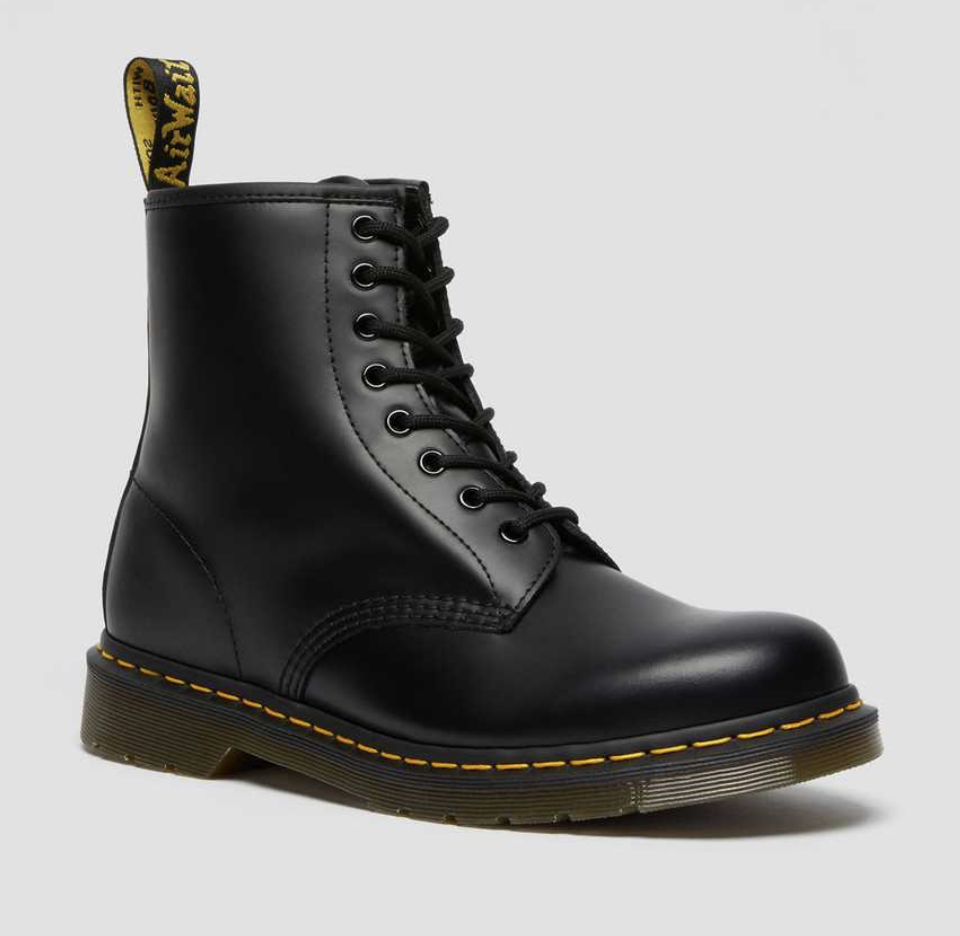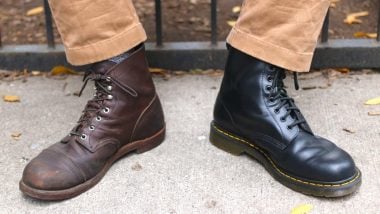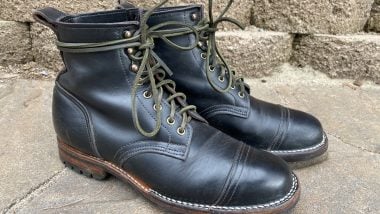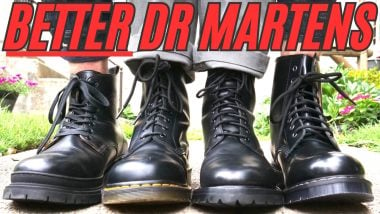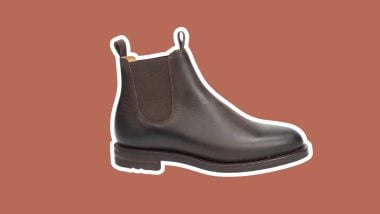Doc Martens Review: Why The 1460s Are Overrated
They made Doc Martens in England for a long time, but after nearing bankruptcy in 2003, they moved production to China and Thailand. Now, Dr. Martens only makes one percent of their shoes in England.
But Docs remain a symbol of Cool Britannia, so let’s review the Asian-made “classic” Doc Marten 1460s.
Key Takeaways
Doc Martens’ lack of half sizes, no shank, ankle slippage, and lack of contour to the foot made them uncomfortable despite the soft, squishy, air-cushioned soles. They’re very casual with their bright stitching, thin leather, and chunky soles, giving them a somewhat youthful vibe that may or may not work for your personal style.
The 1460's combat boot silhouette, combined with a cushy sole and trademark contrast welt stitching, has kept customers coming back for nearly 80 years.
Pros & Cons
Here’s the summary of Doc Marten’s famous 1460s.
What I like about Dr. Martens
- Very cheap
- Super soft sole
- Water resistant
- Casual, can be worn with a t-shirt
- Cultural icon
Downsides
- High shaft
- Laces come undone easily
- Hard to resole
- Shapeless
- Doesn’t fit well
- No shank
- Leather is thin
- Not versatile
- Not very mature
- A little feminine
Dr. Martens Overview
A weird fact I hadn’t heard before researching these boots: Dr. Klaus Märtens, a doctor in the German Army in 1945, designed the first Dr. Martens boot.
You know, the army that the Nazi party was running at the time. Now, to be fair, a lot of Germans were forcibly conscripted into the army.
He injured his ankle while skiing and found that the Nazis’ standard-issue army boots were uncomfortable on his injured foot, so he designed a new boot made with air-padded soles made from tires.
He eventually started a business making soles, initially using discarded rubber from Luftwaffe airfields — the Nazi air force. From the beginning, Dr. Martens boots were marketed as a solution for injuries, orthopedic foot problems, and age-related foot pain. For the first decade, 80 percent of their sales came from housewives over 40.
Somehow, their target market went from being that uncool to being incredibly cool, and as the 20th century progressed, this iconic footwear brand became the unofficial boot of skinheads, punks, and grunge musicians.

Dr. Martens 1460 First Glance
- Shiny, corrected grain leather
- Mostly single-stitched
- Over 7 inches tall
- Pretty shapeless
- Characteristic yellow stitching
This is an uncomplicated boot: Doc Martens 1460’s “full grain” highly corrected, smooth, and shiny, giving the boot a plasticky and relatively thin feel. Mostly single-stitched, it lacks the durability of boots with triple or quadruple stitching like White’s. It’s over seven inches tall, so long socks are a must, and the design isn’t particularly streamlined or contoured.
It’s mostly single-stitched, lacking the durability of boots with triple or quadruple stitching like White’s. Standing over seven inches tall, it requires long socks, and the design isn’t very streamlined or contoured. The toe is rather stubby.
Otherwise, the most characteristic things about 1460 are the famous yellow stitching around the welt and the famously squishy rubber sole. Both of these make for leather boots that don’t look particularly elegant, but I think that’s the point — people want these boots to look hip.
Martens made über casual boots that are utterly impossible to dress up, but they pass in a lot of outfits and environments that wouldn’t otherwise be boot-friendly.
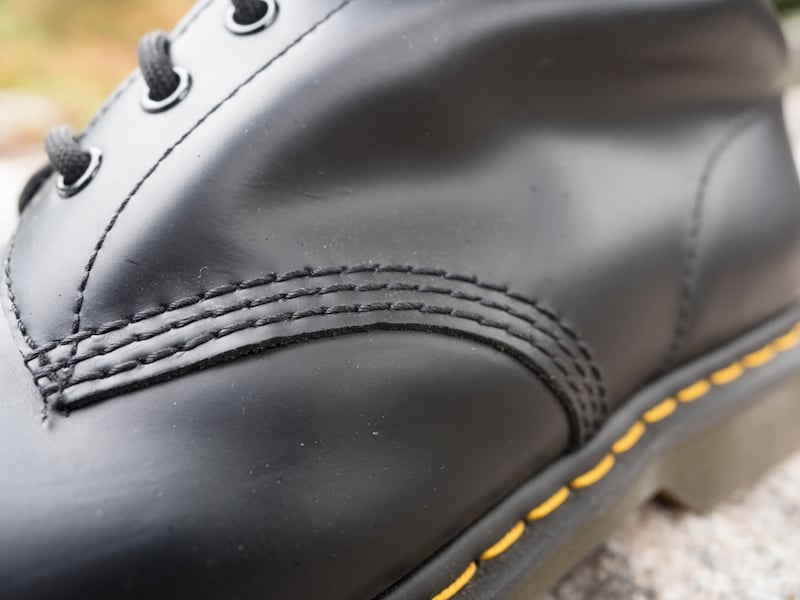
Doc Martens 1460 Leather
- Comes from South America or Asia
- Super corrected leather
- A little plasticky and stiff leather
- Available in many colors/patterns
When I spoke with their helpline, they told me that this leather comes from “either South America or Asia,” which is a pretty broad net to cast, but that’s the only information they gave me.
Now, the company describes this as “full grain leather” even though it’s very, very smooth and doesn’t have a trace of grain on the skin. This leather is actually corrected — smoothed down — but since it comes from the top layer of the hide and isn’t suede or roughout, Dr. Martens’ representative called it full grain. If you’re a leather purist, you might see “corrected full grain leather” as a contradiction, so I’ll refer to it as corrected grain to be safe.
This leather is so smooth that, in my opinion, it looks quite plasticky. There’s no real surprise there; everyone knows what Doc Martens looks like before they buy them, and this is an aesthetic that speaks to a lot of people, but in my opinion, this leather looks as cheap as it is.
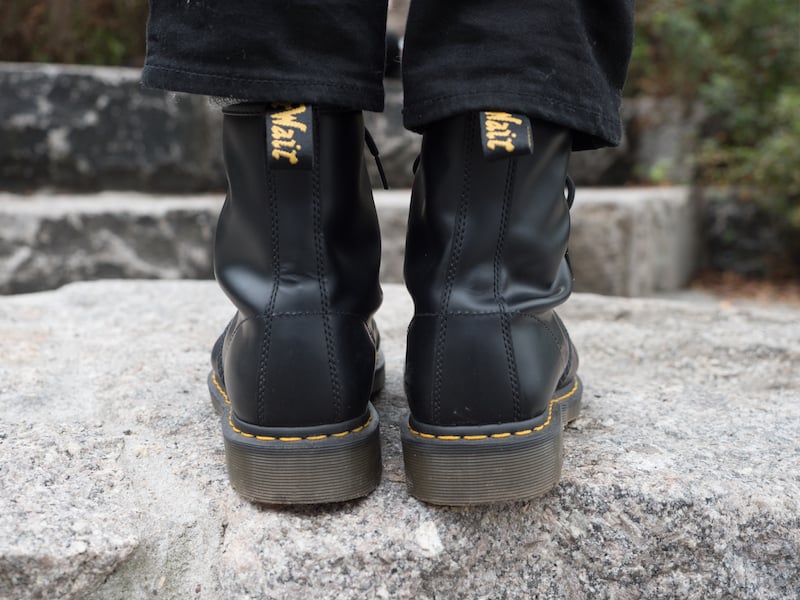
Their packaging describes it as
“Durable and famously stiff to start with, it moulds to your feet and gets more comfortable with wear. smooth leather can be polished to a dapper shine or artfully scuffed up, depending on your preference.”
Now, this is the very classic 1460 leather, which they describe as having “a smooth, semi-bright appearance.”
One of the good things about buying from such an enormous company: they have a ton of other leathers to choose from. I picked the classic leather because it’s the most popular and I wanted the review to be relevant to the most people.
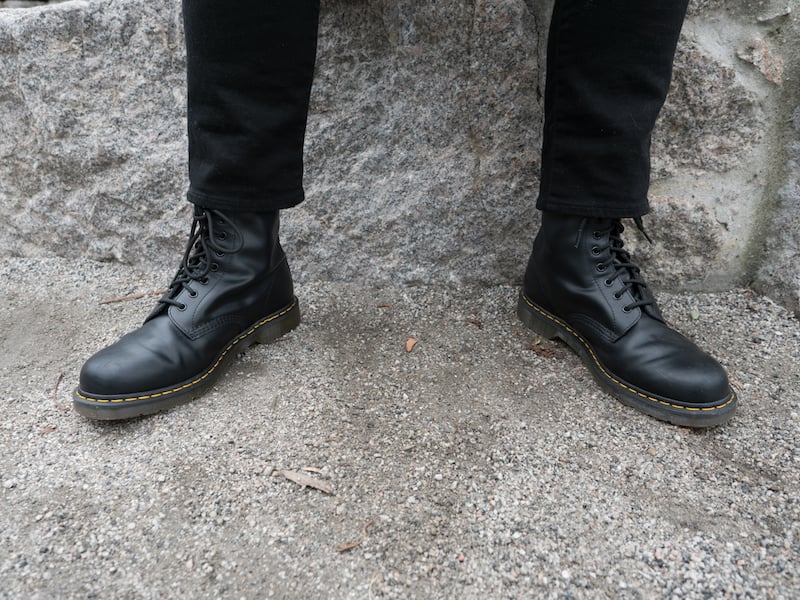
Dr. Martens Leather Care
- Doc Martens suggests their “Wonder Balsam“
- Made of lanolin, beeswax, coconut oil
- Use once a month
- Dubbin Polish will add a thicker wax layer
The company promotes their “Wonder Balsam” leather conditioner, made from lanolin, beeswax, and coconut oil, for maintaining their “soft” leather. It’s meant to soften and polish the leather, recommended for use every six months or as needed based on wear and dryness.
[Related: The 5 Best Boot Conditioners You Can Buy]
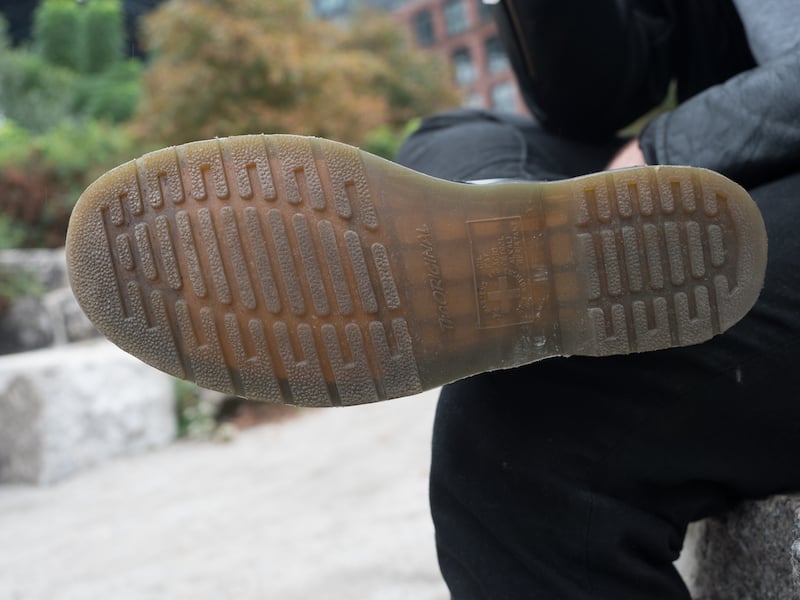
Dr. Martens Sole
- Super soft air cushioned sole
- Great shock absorption
- No shank
- Hard to resole
This is the main event. The sole is what made Dr. Martens famous, and it’s made from an inorganic rubber that’s oil and fat-resistant. It really is super soft; as I mentioned above, it was originally used for people with orthotic concerns or foot pain.
While it’s not at all dressy, this is meant to be a comfy, casual boo,t and I have to saythe sole was my favorite thing about the boot. The shock absorption is great, the rubber is soft but not too soft, and it’s a delight to walk around in. I did find it’s a little squeaky on indoor surfaces, but that may change as the shoes get older.
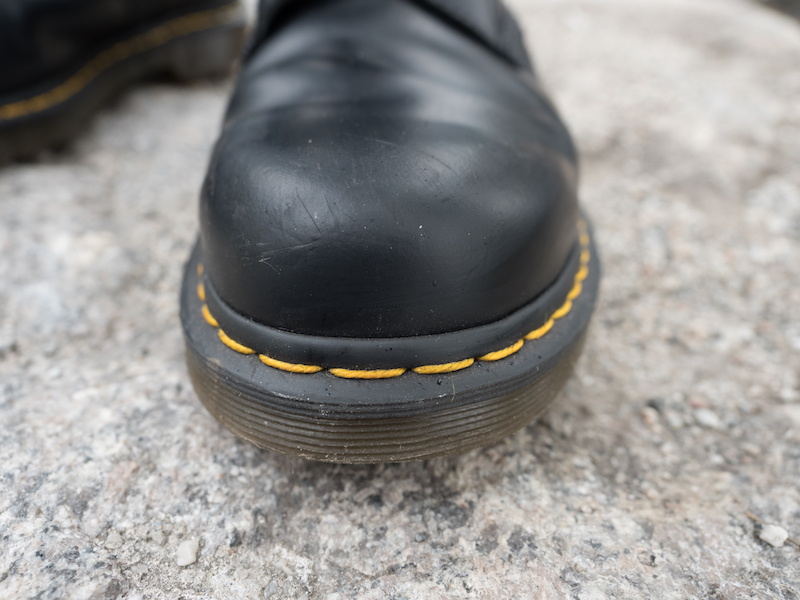
After the rubber, there’s what the guy on the phone called a “cork material,” and then the insole is a “vegan material” that he then clarified is polyurethane foam, which would further add to the shock absorption.
A few downsides to this sole: there’s no shank, which means it’s not as stable as other boots, and it’s very hard to resole. If you’re asking, “But isn’t this a Goodyear welt?” well, I know what you mean. It’s a weird kind of Goodyear welt, and just as Doc Martens calls this “full grain leather,” I feel like they’re playing fast and loose with their terms, here. For these shoes, the upper is heat-sewn to the sole with flame. You can see it in this neat video below, which should start at the welling.
Yes, it looks cool, but while some cobblers do specialize in resoling these shoes, you shouldn’t expect to be able to resole them. But then, the sole is super long-lasting, and the upper isn’t that long-lasting, so it probably won’t be an issue.
Dr. Martens Fit & Sizing: Are Docs Comfortable?
- No half sizes
- Size down
- Sole is crazy soft
- Doesn’t fit the foot that well
For men, the sizes run from 6 to 14. There’s just one width available and no half sizes. To find your fit, they recommend sizing down one half to one full size — I’m an 11.5, and the size 11 fits me fine. But with no half sizes and no other widths, they’re making the shoe somewhat inaccessible to, what, half the population?
As for walking around and breaking them in, there are a few things worth pointing out:
- Number 1: The sole is crazy soft, which made for a pretty nice experience.
- Number 2: The lack of a shank was clear. A lot of people feel like a shank is the most important part of a shoe, and purists will be disappointed by this.
- Number 3:Iin general, it just doesn’t fit the foot very well. I often have ankle slippage, and I find it simply doesn’t contour to the foot very well. To be fair, I’m coming off a pair of White’s Service Boots, which fit better than almost any other shoe I’ve tried.
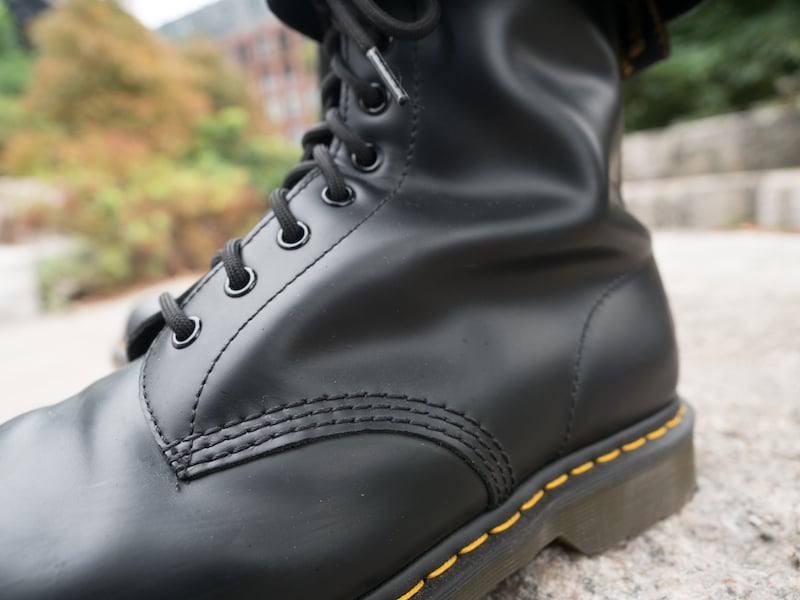
But my Docs give me quite a bit of slippage, and more importantly, I just didn’t find it contoured the foot as ergonomically as it should have. This is a brand that began as a means for helping people recover from foot injuries, so I was expecting something more ergonomic, but alas, it’s just a pretty blobby, generic fit.
All I’ve ever heard about these boots is that they’re hard to break in, but personally, I didn’t really have issues. I think that’s because these are Asian-made Docs, not the pricier ones made in England. Sure, I got a little abrasion on my pinky toe, but otherwise, I didn’t have problems.
[Get the lowdown on fit in my ultimate guide to how boots should fit.]
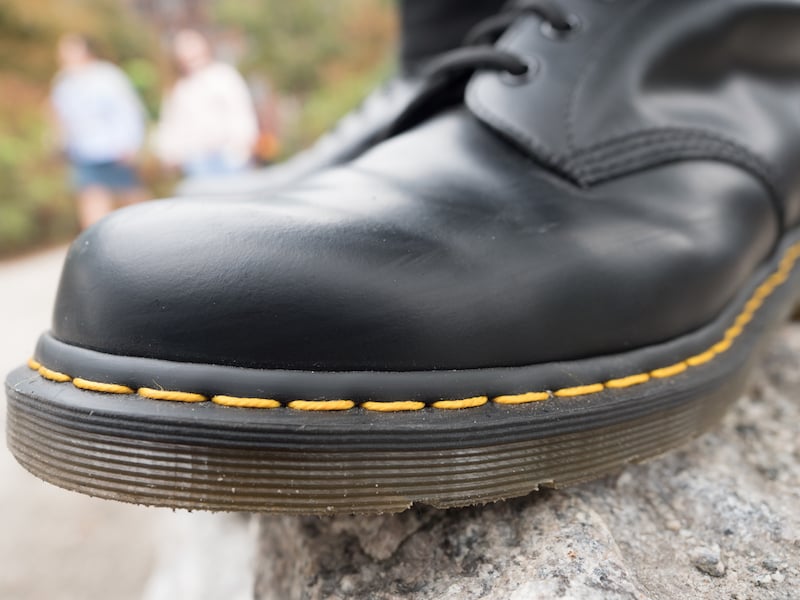
Dr. Martens Price
The 1460s will run you $170. If you prefer the made-in-England Docs, those are usually closer to $260.
Some people say the British Doc Martens boots are better quality. In my experience with matters like these, they’re probably just being wistful for a less globalized world. (See also the American-made Thursday boots, made in response to people thinking Mexican-made means poor quality.) Some say the leather is thicker in the British version. Others say it’s thinner. In any case, I haven’t tried them out and can’t say either way.
The 1460's combat boot silhouette, combined with a cushy sole and trademark contrast welt stitching, has kept customers coming back for nearly 80 years.
The Verdict
I don’t like these boots. Sure, they’re casual, but they’re so casual I feel very weird wearing these with anything other than black jeans, and if I’m being honest, they really are a brand that’s targeted very squarely at youth culture.
These are boots for teenagers.
The bright yellow stitching really drags down the maturity of these boots, as does the plasticky nature of the leather and the chunky rubber sole. I know I’ll make enemies saying this, but they simply aren’t grown-up boots. If I see a man in his 30s, 40s, or 50s wearing these, my immediate thought is that he didn’t get the memo that adults are allowed to wear nicer boots.
Now, I know that might be the point — they’re not for stuffy olds, they’re an icon of rebellious youth, of sullen teenagers, of flannel skirts. But on that note, these are unisex boots. I think it’s fair to say that when women wear them, it’s to give their outfit a tougher, more masculine edge. When a man wears them? I think they feminize his outfit.
Further Reading
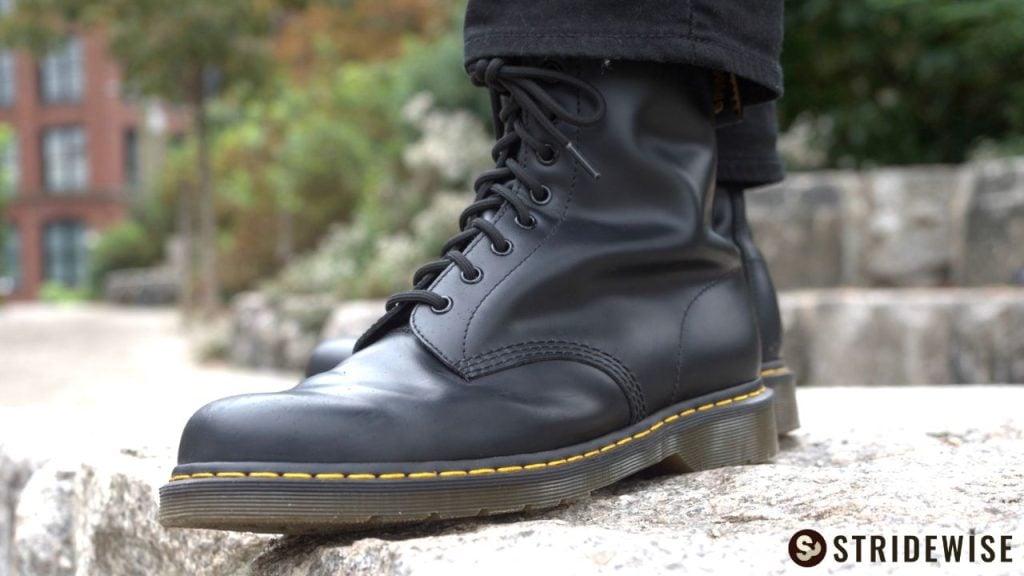
How To Break In Doc Marten Boots
Despite some of our controversial opinions on Doc Martens, we understand that they are very popular.
Check out how →
I’m not saying that’s an objectively bad thing or that no man should ever wear these, I’m just saying that the yellow thread, the shapeless form, this cheap, crappy leather, and the association with grunge and punk make for a boot that just looks like it’s meant for boys and women.
It’s meant for youth culture and rock’n’roll culture, and if you fall into one of those camps, enjoy them. If you don’t, I don’t know why you’d wear them.
[Related: My list of The Best Boots for Men]
FAQs: Doc Martens 1460
Should I size up or down for Doc Martens 1460?
I recommend sizing down at least half size. I wear a US size 11 and sized down to a US size 10 because Doc Martens do not offer half sizes.
What does 1460 mean in Doc Martens?
1460 is the model number for the original Dr. Martens was made on April 1st, 1960. The number represents the date 1 (1st), 4 (April), and 60 (1960).
Are Dr Martens 1460 good for winter?
Dr. Martens 1460 are fine for winter, but they are not insulated. If you plan on wearing them with thick socks take that into account when sizing Dr. Martens.
What is the difference between Doc Martens 1460 and 1490?
The 1490 is a higher boot with 10 eyelets. The 1460 has 8 eyelets and is a bit shorter than the 1490. They use the same construction and leather.
Which Dr. Martens should I get?
If you want the classic look, get the 1460. If you want a more ‘modern’ punk look, get the 1490. If you want a slip-on, get the 2976.

